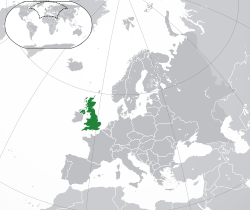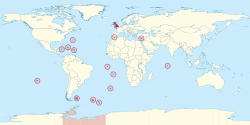
Back Британиаду Abkhazian Keurajeuën Inggréh ACE Британиешхо Пачъыхьыгъо ADY Verenigde Koninkryk Afrikaans Vereinigtes Königreich ALS የተባበሩት የሀገር ንጉሳዊ አገዛዝ Amharic United Kingdom AMI Reino Uniu AN Ġeānod Cynerīċe ANG यूनाइटेड किंगडम ANP
United Kingdom of Great Britain and Northern Ireland | |
|---|---|
| Anthem: "God Save the King"[note 2]
| |
Location of the United Kingdom (dark green) on the European continent (dark grey) | |
| Capital and largest city | London 51°30′N 0°7′W / 51.500°N 0.117°W |
| Official language | British English (de facto) |
| Regional or minority languages[note 3] | |
| Ethnic groups (2011) | |
| Religion |
|
| Demonym(s) | |
| Constituent countries | |
| Government | Unitary parliamentary constitutional monarchy |
• Monarch | Charles III |
| Keir Starmer | |
| Legislature | Parliament of the United Kingdom |
| House of Lords | |
| House of Commons | |
| Formation | |
| 1535 and 1542 | |
• Union of the Crowns under James VI and I | March 24, 1603 |
| May 1, 1707 | |
| January 1, 1801 | |
| December 5, 1922 | |
| January 1, 1973 | |
| January 31, 2020 | |
| Area | |
• Total | 242,495 km2 (93,628 sq mi)[8] (78th) |
• Water (%) | 1.34 |
| Population | |
• 2023 estimate | |
• 2011 census | 63,182,178[10] (22nd) |
• Density | 270.7/km2 (701.1/sq mi) (50th) |
| HDI (2017) | very high · 14th |
| Currency | Pound sterling[note 6] (GBP) |
| Time zone | UTC (Greenwich Mean Time, WET[note 7]) |
• Summer (DST) | UTC+1 (British Summer Time, WEST) |
| Date format | dd/mm/yy yyyy-mm-dd (AD)[12] |
| Mains electricity | 230 V–50 Hz |
| Driving side | left[note 8] |
| Calling code | +44[note 9] |
| ISO 3166 code | GB |
| Internet TLD | .uk[note 10] |
The United Kingdom of Great Britain and Northern Ireland, often shortened to the United Kingdom (or UK), or just Britain, is a sovereign country in Western Europe. It is a constitutional monarchy of four countries which were once separate: England, Wales, Scotland and Northern Ireland.
It is part of the United Nations, the Commonwealth of Nations, NATO, the G7, and formerly the European Union. It had the sixth largest economy in the world by nominal GDP in 2019.
About 95 percent of the UK's population are English speakers.[13] 5.5 per cent of the population speak languages brought to the UK as a result of relatively recent immigration.[13]
The UK has many cities. London is the largest city in the UK and is the capital city. There are also other large cities in England such as Birmingham, Manchester, Liverpool, Leeds, Bristol and Newcastle upon Tyne. Scotland has the large cities of Edinburgh and Glasgow. Cardiff and Swansea are in Wales and Derry and Belfast are in Northern Ireland.
Between the 17th and mid 20th-centuries, Britain became a world power. It became a colonial empire that controlled large areas of Africa, Asia, North America and Oceania.[14]
At its height in 1922, more than 458 million people lived in the British Empire, one-fifth of the Earth's population. Its area was 13,012,000 square miles: almost a quarter of the Earth's land area. The Empire was sometimes called 'the Empire on which the Sun never sets', meaning it is always daytime someplace in the Empire. Many countries left and became independent from the Empire in the 20th century, although Britain keeps links with most countries of its former empire and also still controls fourteen colonies.
Cite error: There are <ref group=note> tags on this page, but the references will not show without a {{reflist|group=note}} template (see the help page).
- ↑ "National Anthem". Official web site of the British Royal Family. 15 January 2016. Archived from the original on 2 September 2014. Retrieved 4 June 2016.
- ↑ "List of declarations made with respect to treaty No. 148". Council of Europe. Archived from the original on 12 December 2013. Retrieved 12 December 2013.
- ↑ "Welsh language on GOV.UK – Content design: planning, writing and managing content – Guidance". www.gov.uk. Archived from the original on 4 August 2018. Retrieved 3 August 2018.
- ↑ "Welsh language scheme". GOV.UK. Archived from the original on 4 August 2018. Retrieved 3 August 2018.
- ↑ "Welsh language scheme". GOV.UK. Archived from the original on 2 August 2018. Retrieved 3 August 2018.
- ↑ "UNdata | record view | Population by religion, sex and urban/rural residence". data.un.org. Archived from the original on 24 February 2021. Retrieved 13 October 2018.
- ↑ Philby, Charlotte (12 December 2012). "Less religious and more ethnically diverse: Census reveals a picture of Britain today". The Independent. London. Archived from the original on 4 November 2016. Retrieved 26 November 2017.
- ↑ "Demographic Yearbook – Table 3: Population by sex, rate of population increase, surface area and density" (PDF). United Nations Statistics Division. 2012. Archived (PDF) from the original on 26 August 2020. Retrieved 9 August 2015.
{{cite journal}}: Cite journal requires|journal=(help) - ↑ "United Kingdom Population 2022 (Demographics, Maps, Graphs)". Archived from the original on 17 July 2018. Retrieved 25 September 2019.
- ↑ "2011 UK censuses". Office for National Statistics. Archived from the original on 31 January 2016. Retrieved 17 December 2012.
- ↑ "2018 Human Development Report". United Nations Development Programme. 2018. Archived from the original on 14 September 2018. Retrieved 14 September 2018.
- ↑ See Date and time notation in the United Kingdom.
- ↑ 13.0 13.1 "Languages across Europe: United Kingdom". BBC. Archived from the original on 2 November 2020. Retrieved 4 February 2013.
- ↑ "BBC - History: British History in-depth". www.bbc.co.uk. Archived from the original on 31 March 2011. Retrieved 31 March 2011.




